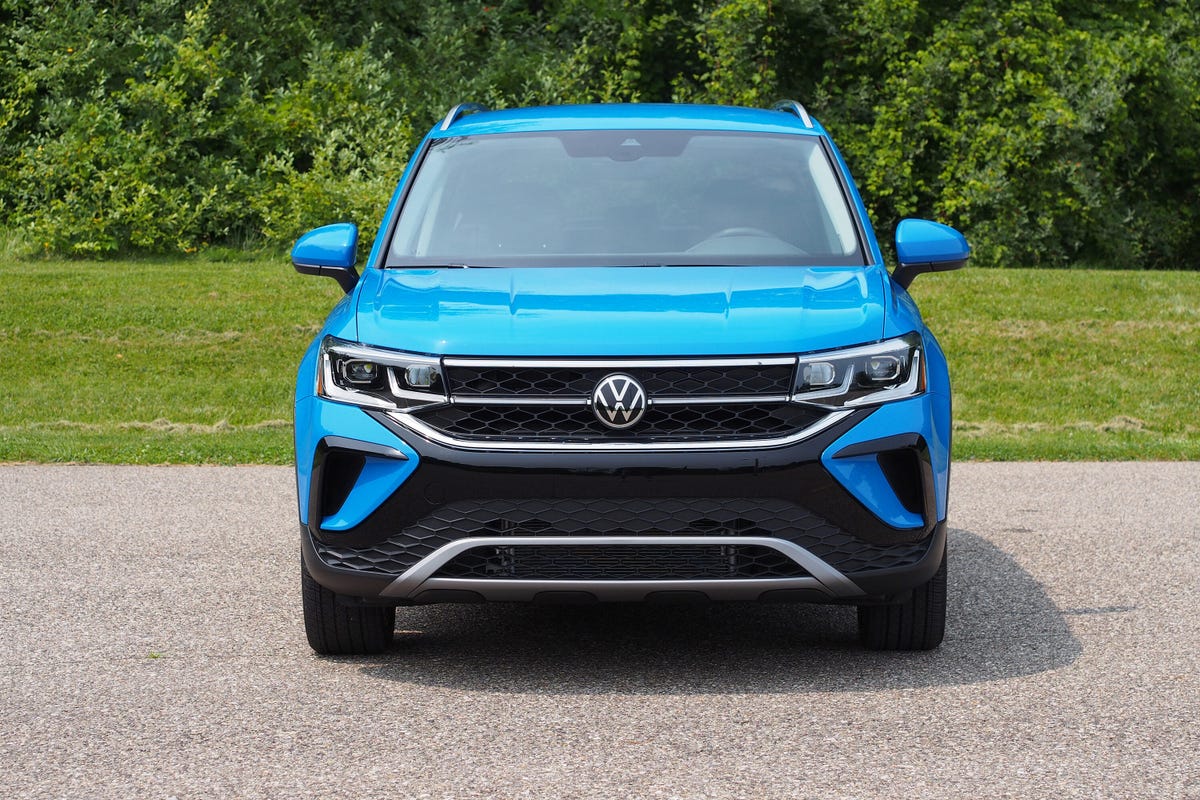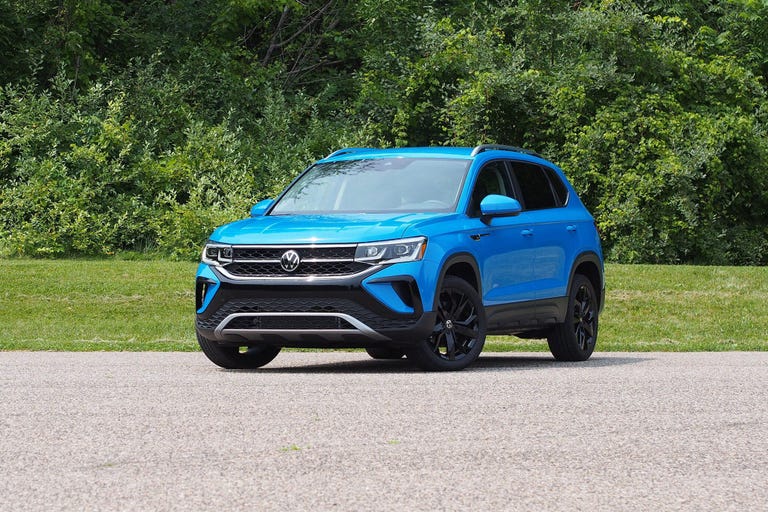 Why You Can Trust CNET
Why You Can Trust CNET 2022 Volkswagen Taos review: Fashionably late
VW took its sweet time introducing a compact SUV, but it was worth the wait.
The new Taos is handsome and surprisingly nice.
When it comes to launching SUVs, Volkswagen's been behind the curve. In response to insatiable customer demand, other automakers have fleshed out their utility-vehicle lineups at a much quicker pace than this Wolfsburg-based company. But giving drivers another choice in the compact SUV segment, the 2022 Volkswagen Taos is finally here, and it was worth the wait.
Like
- Handsome looks
- Solid, Germanic feel
- Cavernous interior
Don't like
- Lethargic throttle response
- Vague steering
Even though it doesn't offer many frills or thrills, this little schlepper nails the fundamentals and checks all the right boxes. The Taos has cavernous amounts of interior space and is plenty comfortable, it's efficient, affordably priced and offers all the advanced driver aids you'd expect. Wrap it all up in pleasantly restrained styling and this VW has no trouble competing with rivals such as the Honda HR-V, Jeep Compass and Subaru Crosstrek. In some ways, the Taos can even give Mazda's ritzy CX-30 a run for its money.
Unlike, say, the Chevy Trailblazer or Hyundai Kona, this Volkswagen is devoid of any visual fireworks, but it's still an attractively styled vehicle. The front end is assertive yet approachable, the body lines are crisp and all the panel gaps are laser straight and millimeter precise. There's a real feeling of fastidious craftsmanship with the Taos. One aspect of this range-topping SEL example that I particularly love is the paint job. Called Cornflower Blue, it may be quaintly named but this color is electric. If this hue is too bright for you, however, more conservative colors are available.
Based on the Volkswagen Group's MQB architecture, which is as ubiquitous as boomers at a Jimmy Buffett concert, the 2022 Taos is refined and astoundingly spacious. Size-wise, it's more than 9 inches shorter than its big brother, the Tiguan , though it's nearly as capacious. The Taos offers nearly 28 cubic feet of luggage space behind the second-row seat. Fold that 60/40 split backrest down and you get just shy of 66 cubes of junk-hauling room. Unusually, all-wheel-drive models are less capacious, but not by much.
The Taos' passenger accommodations are similarly generous. The front bucket seats are cushy, and buyers that opt for an SE or SEL model are treated to an eight-way power driver's chair with adjustable lumbar support. The rear bench offers miles of space in all directions, so even lanky adults should have no trouble getting comfortable and staying that way for hours at a time. From stem to stern, this VW's interior capaciousness is seriously impressive.
It isn't opulent, but the Taos' cabin is very nice for the segment.
What isn't as praiseworthy are some of the cabin's materials. The top of the dashboard is a large swath of hard, cheaply textured plastic. Shiny painted trim runs from door to door and the climate controls feel pretty low rent. These elements are somewhat offset by decent quality leather on the seats and soft plastic on the door uppers, so it's not all bad even if the Taos feels far less premium than the CX-30.
An 8-inch digital instrument cluster is standard, but SEL models feature a fully reconfigurable 10.3-inch panel that is crisp and colorful. As for infotainment tech, three setups are offered. The base Taos comes with a 6.5-inch display, while the midrange and top-shelf models both feature an 8-incher, though the latter also gains embedded navigation. The Taos' infotainment system is not immediately intuitive, but it's simple enough to decipher after poking around for a few minutes. The real head-scratcher, however, is the dial to the right of the screen. It looks like a tuning knob, but you can twirl it all day and the radio stations never change. Instead, this functions like a control knob, allowing you to cycle through some infotainment settings and menus, though it's as inconvenient as it is unintuitive. Simplifying things, Apple CarPlay and Android Auto are standard equipment.
Up to three USB type-C ports are offered in this VW and the top two trims come with a wireless charging plate. Setting the SEL trim apart from the pack, it also boasts of an eight-speaker Beats audio system that sounds pretty good. Ventilated seats are offered in the Taos, though only on the SEL trim and only with all-wheel drive.
Yep, there's an engine underneath that bundle of wires and tubes.
Just one engine is offered here: a 1.5-liter I4. Running on a modified version of the Miller cycle and fitted with a variable-geometry turbocharger, this little dynamo cranks out a respectable 158 horsepower and 184 pound-feet of torque. This engine is reasonably smooth and pretty potent, though it does not stand out in any meaningful way from the powerplants you get in competing vehicles.
Two transmissions are available in the Taos. Front-wheel-drive models (like the one tested here) are fitted with a conventional eight-speed automatic, but variants that feature all-wheel drive come with a seven-speed dual-clutch gearbox. The former unit is generally quick, smooth and responsive, though it can be a bit overeager to upshift at times. This issue, however, is minor compared to the vehicle's throttle response. When taking off in drive, the Taos can feel absolutely lethargic, like it just doesn't want to move unless you push the accelerator halfway down or more. Fortunately, there's a simple solution to this problem: Just click the shifter into Sport mode and it makes the Taos much more responsive at low speeds.
When fitted with front-wheel drive, the Taos should return 28 mpg in the city and 36 mpg on highway drives. Combined, this compact SUV is rated at a respectable 31 mpg, though I've been getting just shy of 36 mpg in mixed driving without even trying, which is super impressive.
The Taos' backseat is spacious and comfortable.
The Taos' interior is cavernous and accommodating, but its driving position is a little off and I can't quite put my finger on why. The relationship between the steering wheel and seat doesn't seem right, like the instrument cluster is too low and the wheel too high. In any event, this compact SUV is no sports car (duh!), but it drives well enough for what it is. The steering is light and on the vague side, though the ride quality is superb, firm but free of any harshness. The chassis absorbs larger impacts without flinching and does an excellent job filtering out vibration and grittiness, practically giving this VW the feel of a German luxury car.
Volkswagen's IQ Drive safety suite is available on S and SE models, though it's standard fare on the SEL version. This technology package includes amenities like blind-spot monitoring, rear cross-traffic alert, automatic emergency braking with pedestrian detection and more. Ever-useful adaptive cruise control with stop-and-go capability is bundled, too. It's smooth and confidence inspiring, working pretty much exactly as advertised. SEL models also come standard with automatic high beams, rear parking sensors and road-sign recognition.
Volkswagen's new Taos was a little late to the party, but it was worth the wait.
Available at dealerships right now, the 2022 Volkswagen Taos is offered in three trims: S, SE and SEL. This compact SUV starts at $24,190 including $1,195 in destination fees. If you want all-wheel drive, plan on spending around $2,000 more. Close to loaded, the front-drive SEL variant featured in this review checks out for just $32,685, a bargain-basement sum for such a spacious and highly functional vehicle.
Volkswagen was conspicuously late to the compact SUV party, but the Taos was worth the wait. Even though it isn't particularly exciting, this SUV does exactly what it needs to and should be a big seller for the brand.



